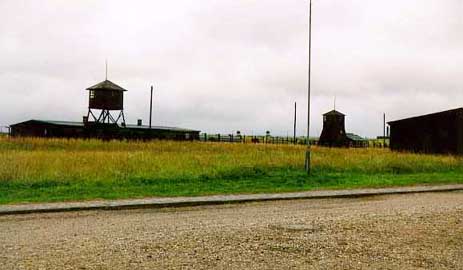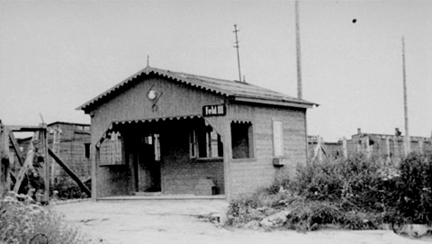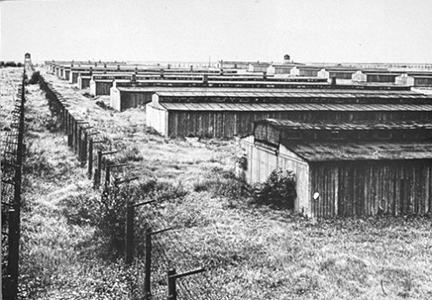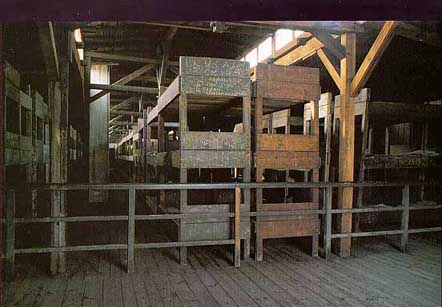Field III at Majdanek The photograph above shows a view of Field III at the former Majdanek concentration camp, taken from the road that runs in front of the clothing warehouse buildings, which are now used to house Museum exhibits. The Majdanek camp was laid out in six compounds, called fields, each surrounded by a barbed wire fence, to separate the different categories of inmates, the same as at Auschwitz in the Birkenau camp. Each field had two rows of barracks on each side of an open space which had a gallows for hanging prisoners. Field I was the closest to the entrance and Fields II, III and IV stretched up a slight slope with Field V at the top, nearest to the crematorium. To the left of Field V, as you are facing up the hill was Field VI, the only field in the uncompleted second row of fields.  The decision to open a concentration camp at Lublin was made by Heinrich Himmler after a visit in July 1941. The original plans for the camp were revised several times, and at one time the plan called for as many as 15 fields, which could house up to 150,000 prisoners who would be used as slave labor in the building of housing for the SS in Lublin. The final plan was changed to 8 fields, but the camp was never finished; the maximum capacity of the camp was 23,000 prisoners. The only barrack buildings that are still standing are in Field III, half way up the slope. In 1997, two reconstructed huts were put up in Field III to fill in empty spaces where some of the original huts, as the barracks buildings were called, were missing. At first, Russian POWs were imprisoned in Field I, and Jewish women and children were in Field V, but later Field I, right next to the gas chamber, was assigned to the Jews. According to a museum booklet, 41% of the 300,000 prisoners who were brought to Majdanek were Jewish and 35% were non-Jewish Polish citizens. The civilian Polish prisoners were mostly peasants, according to the guidebook, which says that only 11% of the prisoners were intellectuals, although there were a few well-known people in the camp. Like Auschwtiz, Majdanek was both a death camp where Jews were taken to be murdered in the gas chambers and a labor camp. The photo below shows prisoners in the Majdanek camp at work.  After the Majdanek camp was liberated, it was still used to house political prisoners, but now the inmates were on the other side of the ideological war. The barracks in Field III were taken over by the NKVD, the secret police of the Soviet Union, and used as a transit camp for Polish citizens who were awaiting shipment to the gulags (concentration camps) in the Soviet Union. These Polish prisoners were, according to the museum booklet, officers and soldiers from the Polish Home Army and the Peasant Battalions who fought as partisans during the war, but were "regarded as enemies of the new political system" because they were not Communists. They became slave laborers in the Soviet Union, right alongside the German Prisoners of War who labored in the gulags for as long as ten years after the war ended. While it was a Nazi camp, conditions in Majdanek were much worse than in most of the other concentration camps; the only other comparable camp was the Auschwitz II camp at Birkenau. The Majdanek camp had no sewer system at first because the Lublin civil authorities, who objected to building the camp so close to the city, would not allow the camp to be connected to the city's main sewer line. It was not until May 1942 that an inspection team from Berlin demanded that the camp be linked to the main sewer system of Lublin, but it was January 1943 before the work was finished. Before the sewer system was installed, prisoners used primitive latrines or just went on the ground; at night when prisoners were forbidden to leave the barracks, they used wooden buckets. It was not until the autumn of 1943 that all the barracks had running water, and even then the prisoners had a bath or shower only about once a month. This lack of sanitation caused many deaths from disease, including typhus, tuberculosis and dysentery. Like the horror camp at Bergen-Belsen, the Majdanek camp later became a camp to which sick prisoners were transferred, starting with the first transport in December 1943 of "persons seriously ill, maimed, exhausted to the extreme with hard labor in other camps," according to the guide book.  After you reach the end of the row of exhibits in the former clothing warehouse buildings, the brick pathway curves to the left and goes through Field III, where there are more exhibits in the barracks buildings. Here, some of the buildings are not stained with black creosote, but are left in their natural wood color, as at Birkenau.  Three of the buildings in Field III have exhibits which show how the inmates lived at various stages of the camp. The photograph above shows the interior of one of the barracks buildings. At first, the prisoners had to sleep on straw-filled thin pallets on the bare ground in buildings which had no wooden floors. These buildings were prefabricated horse barns, designed to be erected as quickly as possible. Wooden floors were added later. In the second stage, the prisoners slept in three-tiered bunks that were the size of a double bed. In the last stage, the bunks were single beds, as shown in the photo above. There was no living space in these dormitory rooms at all, only enough room to walk between the beds. A row of small windows at the top let in the only light or ventilation. 500 to 800 prisoners slept in one barrack building which was designed to hold 52 horse stalls or 250 people. The monument shown in the photo below stands between the barrack buildings in Field III on the roll call place or Appellplatz. According to the Museum guide book, it was erected by the work group led by Stanislaw Zelent, the leader of the Polish Home Army prisoners in Field III. Zelent escaped when the prisoners were evacuated from the camp as the Soviet Army approached, and was able to rejoin the partisans who were fighting the Nazis. The monument was designed by Albin Maria Boniecki, one of the inmates. The monument shows three eagles on top of an urn which contains the ashes of one of the dead prisoners. The White Eagle is a Polish national symbol. The Nazis also used an eagle symbol. Boniecki also did two other works of sculpture while he was a prisoner in the camp, including the turtle which is pictured below in its original spot on Field III. It is now displayed in one of the exhibit buildings along with another sculpture of an animal, which Boniecki did. These animal sculptures are quite large, approximately 3 feet in diameter. This artwork was not done in secret, but was encouraged by the SS administrators at the camp.  Mausoleum at MajdanekBack to start of TourBack to Majdanek indexHome |